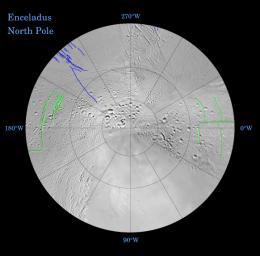Fractures on the surface of Enceladus record a long and complex history of tectonic activity. Many of the geologically youngest fractures define remarkably systematic patterns relative to Enceladus' axis of rotation, as well as to its tidal orientation (that is, the longitudes that point toward and away from Saturn).
These fracture patterns offer clues to global changes of shape that the satellite has undergone over time, possibly in response to tidal forces exerted by Saturn or as a result of changes in the internal structure of the icy moon. Some of the most prominent global patterns of fracture are delineated in color in the northern hemisphere map shown here. This map is being released along with a southern polar projection map (See PIA07722).
This map is a polar stereographic projection that was mosaicked from the best-available Cassini and Voyager clear-filter images. The map is centered on the north pole and coverage extends to the equator. Gridlines show latitude and longitude in 30-degree increments. The same maps are available without colored fracture lines; see PIA07719 and PIA07720.
Terrain near the north pole is among the most heavily cratered and oldest on the surface of Enceladus. The conspicuously fractured southern polar region (PIA07722) is nearly devoid of impact craters, making this terrain among the youngest on the moon's surface.
A unique feature of the south polar terrains is that broad networks of folded or kinked fractures can be found throughout the region. A prominent "chain" of these fractures (marked in red in the south polar map) abruptly separates the youthful south polar terrains from the older terrains that lie closer to the equator and appears to encircle the south pole near about 55-degrees south latitude.
The wavy boundary of the south polar terrain is interrupted in numerous places by Y-shaped, or funnel-shaped, discontinuities that curve and taper northward. Well-developed examples of the funnel-shaped discontinuities appear to transition to systems of north-south trending surface cracks (marked in blue).
These north-south trending cracks are best explained as if they formed in response to tension stresses that are parallel to lines of latitude. Such extensional "hoop stresses" would be expected to develop if the equator became wider, perhaps in response to a change in the moon's spin rate.
Globally systematic patterns of fracture on Enceladus occur in ancient, cratered terrain as well as youthful terrain. Shown in green on the maps -- and particularly apparent in the northern hemisphere projection -- are roughly orthogonal (or perpendicular) systems of north-south and east-west trending fractures that formed quite close to the tidal axis of Enceladus. The moon's tidal axis is a line extending from 0-degrees longitude to 180-degrees longitude. Such orthogonal fractures might have formed in response to tidal stresses exerted on Enceladus by Saturn.
The Cassini-Huygens mission is a cooperative project of NASA, the European Space Agency and the Italian Space Agency. The Jet Propulsion Laboratory, a division of the California Institute of Technology in Pasadena, manages the mission for NASA's Science Mission Directorate, Washington, D.C. The Cassini orbiter was designed, developed and assembled at JPL.
For more information about the Cassini-Huygens mission visit http://saturn.jpl.nasa.gov. For additional images visit the Cassini imaging team homepage http://ciclops.org.

 Planetary Data System
Planetary Data System












